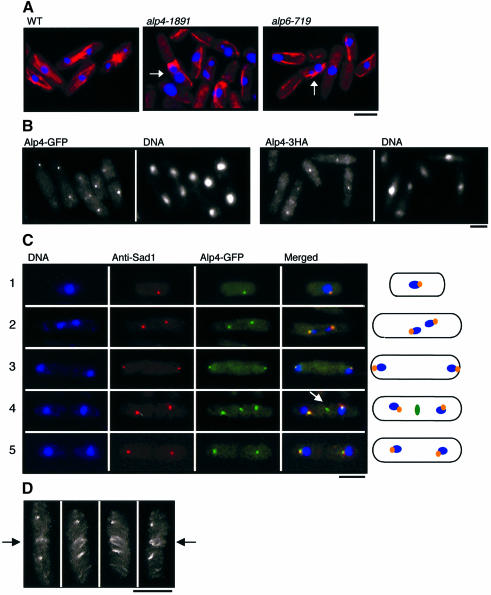Fig. 1. Defective phenotypes of ts alp4 and alp6 mutants and the cellular localization of Alp4 and Alp6 at the MTOC. (A) Wild-type (left, HM123, Table II), alp4-1891 (middle, DH1891) or alp6-719 (right, DH719) cells were incubated at 36°C for 6 h and processed for immunofluorescence microscopy. Merged images of anti-tubulin staining (TAT-1, red) and nuclear staining (DAPI, blue) are shown. Abnormally segregated mitotic chromosomes are marked with arrows. (B) Localization of Alp4. Fluorescence from GFP (two left panels; Alp4–GFP, LV11) or immunofluorescence microscopy using anti-HA antibody (two right panels; Alp4-3HA, LV15) are shown. (C) Localization of Alp4–GFP during the cell cycle. Triple staining using DAPI (left), anti-Sad1 (the second panels), GFP (the third panels) and merged pictures (right) during the cell cycle are shown. Representative images from interphase (row 1), metaphase (row 2), anaphase (row 3), post-anaphase (row 4) and septated cells (row 5) are presented. In the rightmost corner, combined images are depicted, in which blue corresponds to chromosomal DNA, orange shows the merged images between Sad1 and Alp4, and green presents Alp4 at the equatorial MTOC (marked with an arrow in row 4). (D) ‘Ring’ structures of the equatorial MTOC (shown by arrows, Alp4-3HA). Anti-HA signals from a post-anaphase cell (corresponding to row 4) have been rotating around a vertical axis after observation under a confocal microscope. The bar indicates 10 µm.

An official website of the United States government
Here's how you know
Official websites use .gov
A
.gov website belongs to an official
government organization in the United States.
Secure .gov websites use HTTPS
A lock (
) or https:// means you've safely
connected to the .gov website. Share sensitive
information only on official, secure websites.
